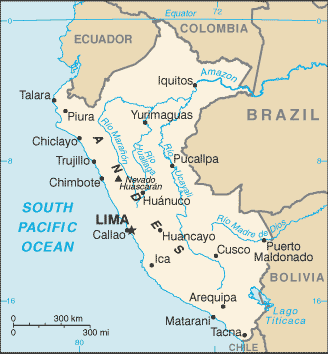|
Peru
|

|
Capital: Lima
Population: 32,510,453
Brief History of Peru:
Peru was inhabited by various tribal peoples throughout most of its ancient history. In the 12th century the small city state of Cuzco was formed from a tribe of the Killkes by their leader Manco Capac. This was the start of the Inca Empire. Over the next several hundred years the Inca Empire would expand to conquer Peru, much of Ecuador, parts of Bolivia, and northern Chile. The Inca civilization was highly developed when the Spanish arrived in 1531.
Spanish Conquistador Francisco Pizarro conquered the Incas and captured Cuzco in 1533. The Spanish soon discovered gold and silver in the Andes Mountains and Peru became a great source of Spanish wealth and power. In 1535 Francisco Pizarro established the city of Lima. Lima became the capital of the area and is a major world city to this day. Peru declared independence in 1821. With the help of South American liberation heroes Jose de San Martina and Simon Bolivar, Peru was able to defeat the Spanish and become a free country.
The Geography of Peru
Total Size: 1,285,220 square km
Size Comparison: slightly smaller than Alaska
Geographical Coordinates: 10 00 S, 76 00 W
World Region or Continent: South America
General Terrain: western coastal plain (costa), high and rugged Andes in center (sierra), eastern lowland jungle of Amazon Basin (selva)
Geographical Low Point: Pacific Ocean 0 m
Geographical High Point: Nevado Huascaran 6,768 m
Climate: varies from tropical in east to dry desert in west; temperate to frigid in Andes
Major cities: LIMA (capital) 8.769 million; Arequipa 778,000 (2009), Trujillo, Chiclayo
The People of Peru
Type of Government: constitutional republic
Languages Spoken: Spanish (official), Quechua (official), Aymara, and a large number of minor Amazonian languages
Independence: 28 July 1821 (from Spain)
National Holiday: Independence Day, 28 July (1821)
Nationality: Peruvian(s)
Religions: Roman Catholic 81%, Seventh Day Adventist 1.4%, other Christian 0.7%, other 0.6%, unspecified or none 16.3% (2003 est.)
National Symbol: vicuna (a camelid related to the llama)
National Anthem or Song: Himno Nacional del Peru (National Anthem of Peru)
Economy of Peru
Major Industries: mining and refining of minerals; steel, metal fabrication; petroleum extraction and refining, natural gas; fishing and fish processing, textiles, clothing, food processing
Agricultural Products: coffee, cotton, sugarcane, rice, potatoes, corn, plantains, grapes, oranges, coca; poultry, beef, dairy products; fish
Natural Resources: copper, silver, gold, petroleum, timber, fish, iron ore, coal, phosphate, potash, hydropower, natural gas
Major Exports: copper, gold, zinc, crude petroleum and petroleum products, coffee
Major Imports: petroleum and petroleum products, plastics, machinery, vehicles, iron and steel, wheat, paper
Currency: nuevo sol (PEN)
National GDP: $302,000,000,000
** Source for population (2012 est.) and GDP (2011 est.) is CIA World Factbook.
Back to Geography Home Page
